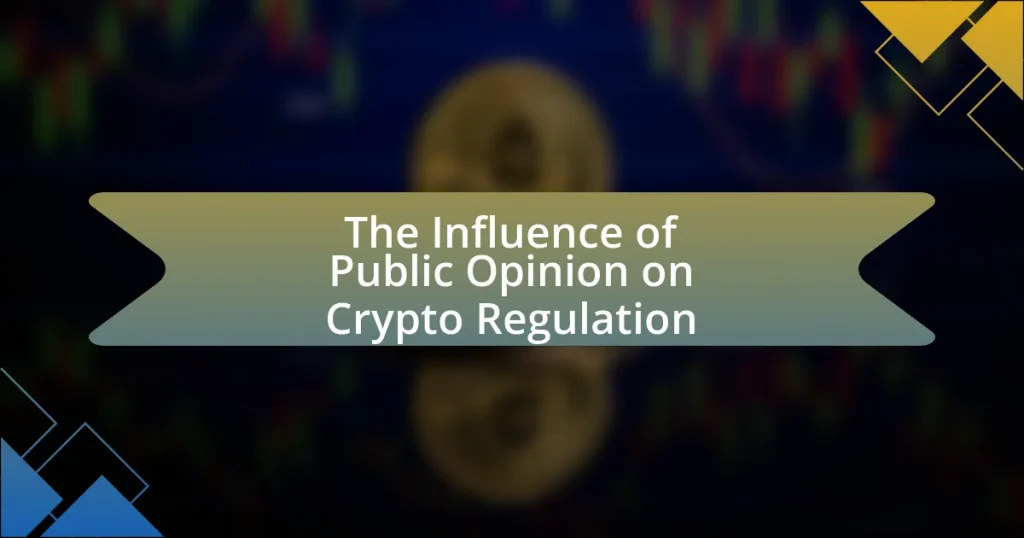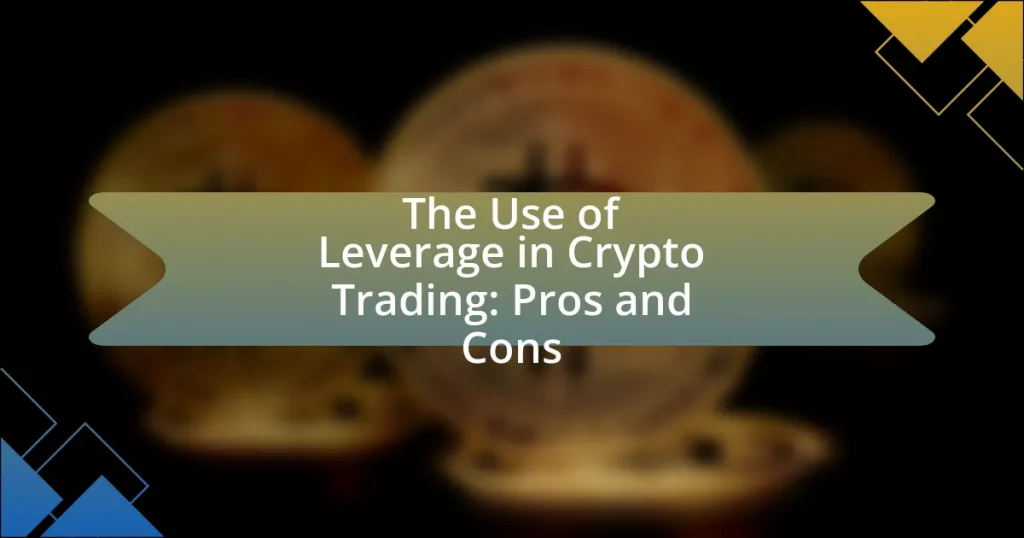The article examines the significant influence of public opinion on cryptocurrency regulation, highlighting how public sentiment shapes policymakers’ decisions and regulatory frameworks. It discusses key factors affecting public opinion, including media coverage, technological advancements, and demographic influences, while also addressing the role of social media in shaping perceptions. The article further explores the implications of public trust and sentiment on regulatory approaches, the responses of various stakeholders, and the methodologies used to gauge public opinion. Overall, it underscores the dynamic relationship between public perception and the evolving landscape of cryptocurrency regulation.
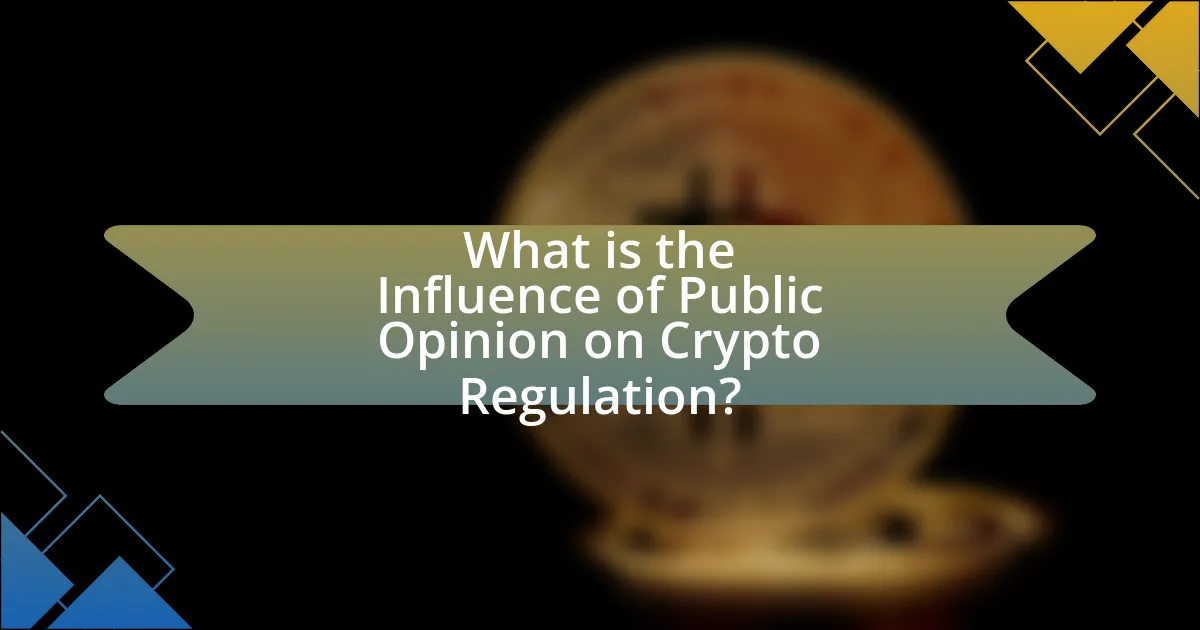
What is the Influence of Public Opinion on Crypto Regulation?
Public opinion significantly influences crypto regulation by shaping policymakers’ perceptions and decisions. When a substantial portion of the public expresses concern about issues such as fraud, security, or environmental impact related to cryptocurrencies, regulators often respond by implementing stricter regulations to address these concerns. For instance, surveys indicate that a majority of Americans support increased regulation of cryptocurrencies, which has prompted legislative efforts in various jurisdictions to create frameworks that govern their use. This correlation between public sentiment and regulatory action demonstrates that as public awareness and opinion evolve, so too does the regulatory landscape surrounding cryptocurrencies.
How does public opinion shape regulatory frameworks for cryptocurrencies?
Public opinion significantly shapes regulatory frameworks for cryptocurrencies by influencing policymakers and regulatory bodies to align their decisions with the sentiments of the public. When a substantial portion of the population expresses concerns about issues such as security, fraud, or market volatility, regulators often respond by implementing stricter regulations to address these fears. For example, in 2021, the rise of public concern over cryptocurrency scams led to increased scrutiny and regulatory actions in various countries, including the United States and the European Union, where authorities proposed new regulations aimed at protecting consumers and ensuring market integrity. This demonstrates that public sentiment can directly impact the speed and nature of regulatory responses in the cryptocurrency sector.
What are the key factors that influence public opinion on cryptocurrencies?
Key factors that influence public opinion on cryptocurrencies include media coverage, regulatory developments, technological advancements, and public perception of security and risk. Media coverage shapes narratives and informs the public about cryptocurrencies, often swaying opinions based on the tone and content of reporting. Regulatory developments, such as government policies and legal frameworks, directly impact how individuals view the legitimacy and safety of cryptocurrencies. Technological advancements, including improvements in blockchain technology and security measures, can enhance public trust and interest. Lastly, public perception of security and risk, influenced by high-profile hacks or scams, can lead to skepticism or enthusiasm towards cryptocurrencies. For instance, a 2021 survey by Pew Research Center indicated that 86% of Americans had heard of cryptocurrencies, with varying levels of trust based on recent news and regulatory actions.
How do social media and news coverage impact public perception of crypto?
Social media and news coverage significantly shape public perception of cryptocurrency by influencing awareness, understanding, and sentiment. Research indicates that social media platforms, such as Twitter and Reddit, serve as primary sources of information and discussion about cryptocurrencies, often leading to rapid shifts in public sentiment based on trending topics or influential figures’ opinions. For instance, a study by the University of Technology Sydney found that positive news coverage can lead to increased investment in cryptocurrencies, while negative reports can trigger sell-offs, demonstrating a direct correlation between media narratives and market behavior. Additionally, the volatility of crypto markets is often exacerbated by social media hype or fear, as seen during events like the Dogecoin surge, where social media buzz significantly impacted its price. Thus, the interplay between social media, news coverage, and public perception plays a crucial role in shaping the cryptocurrency landscape.
Why is public opinion important in the context of crypto regulation?
Public opinion is crucial in the context of crypto regulation because it shapes policymakers’ decisions and influences legislative outcomes. When a significant portion of the public supports or opposes specific regulatory measures, elected officials are more likely to respond to these sentiments to maintain their political capital and voter support. For instance, a survey by the Pew Research Center in 2021 indicated that 86% of Americans had heard of cryptocurrency, and public awareness can drive demand for regulatory clarity and consumer protection. This demonstrates that public sentiment can directly impact the regulatory landscape, as officials may prioritize regulations that align with the views of their constituents to ensure compliance and foster trust in the financial system.
How can public sentiment affect policymakers’ decisions on crypto?
Public sentiment significantly influences policymakers’ decisions on cryptocurrency regulation. When a substantial portion of the public expresses support or concern regarding crypto, policymakers often respond by aligning their regulatory approaches with these sentiments to maintain public trust and political support. For instance, in 2021, the surge in public interest and investment in cryptocurrencies led to increased scrutiny and calls for regulation from various governments, including the U.S. and the EU, reflecting the urgency to address public concerns about fraud and market volatility. This correlation between public opinion and regulatory action demonstrates that policymakers are likely to prioritize regulations that resonate with the prevailing sentiments of their constituents.
What role does public trust play in the acceptance of crypto regulations?
Public trust is crucial for the acceptance of crypto regulations, as it directly influences individuals’ willingness to comply with and support regulatory frameworks. When the public perceives regulatory bodies as transparent, competent, and aligned with their interests, they are more likely to embrace regulations that govern cryptocurrencies. For instance, a survey conducted by the Cambridge Centre for Alternative Finance in 2021 indicated that 70% of respondents expressed a preference for clear regulations, highlighting that trust in regulatory authorities can enhance public acceptance. Conversely, a lack of trust can lead to resistance against regulations, as seen in various jurisdictions where skepticism about government intentions has hindered regulatory progress. Thus, public trust serves as a foundational element that can either facilitate or obstruct the implementation of effective crypto regulations.
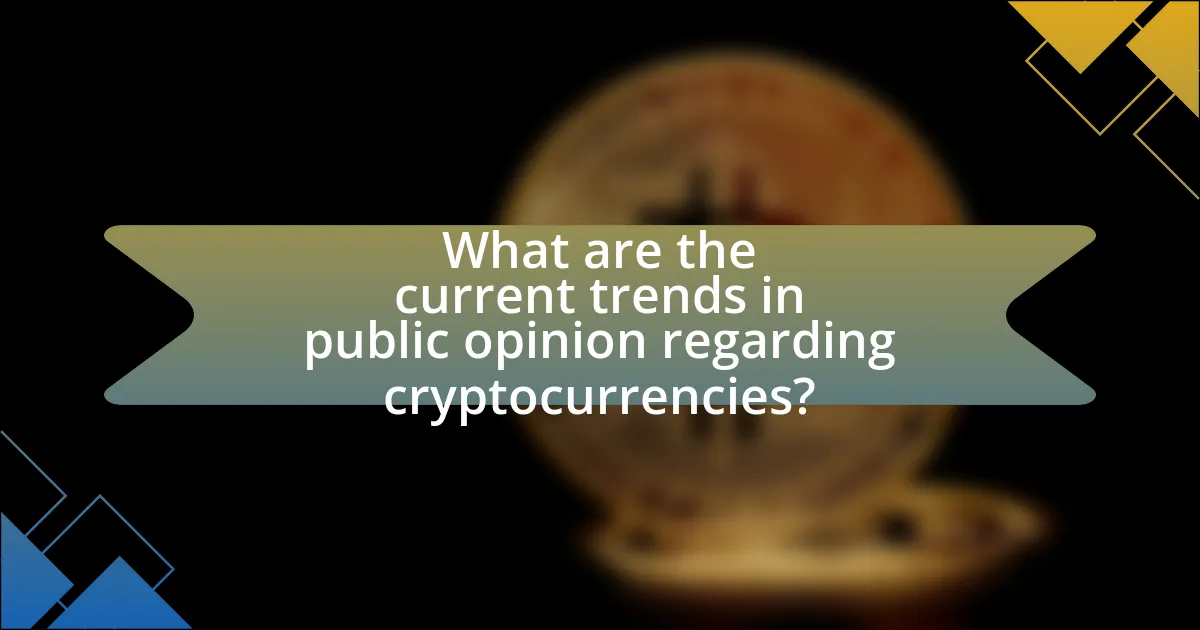
What are the current trends in public opinion regarding cryptocurrencies?
Current trends in public opinion regarding cryptocurrencies indicate a growing acceptance and interest among the general population, with a significant portion of individuals viewing cryptocurrencies as a legitimate investment. According to a survey conducted by Pew Research Center in 2023, approximately 46% of Americans reported that they believe cryptocurrencies are the future of money, reflecting an increase in positive sentiment compared to previous years. Additionally, concerns about regulation and security remain prevalent, with 62% of respondents expressing the need for more government oversight to protect investors. This duality in public opinion highlights both optimism for the potential of cryptocurrencies and caution regarding their risks, influencing ongoing discussions about regulatory frameworks.
How has public opinion shifted over the past few years?
Public opinion regarding cryptocurrency has shifted significantly over the past few years, moving from skepticism to increased acceptance and support. According to a 2021 survey by Pew Research Center, 86% of Americans have heard of cryptocurrency, up from 75% in 2019, indicating growing awareness. Additionally, a 2022 Gallup poll revealed that 41% of Americans view cryptocurrency as a good investment, a notable increase from previous years. This shift in perception has influenced regulatory discussions, as lawmakers are increasingly considering public sentiment in their approaches to crypto regulation.
What events have significantly influenced public perception of crypto?
Significant events that have influenced public perception of crypto include the 2017 Bitcoin price surge, regulatory announcements, high-profile hacks, and the rise of decentralized finance (DeFi). The 2017 Bitcoin price surge, where Bitcoin reached nearly $20,000, attracted widespread media attention and public interest, leading to increased investment and speculation. Regulatory announcements, such as the U.S. SEC’s stance on ICOs and the establishment of clearer guidelines, have shaped public trust and understanding of the legitimacy of cryptocurrencies. High-profile hacks, like the Mt. Gox incident in 2014, raised concerns about security and the risks associated with crypto investments. Additionally, the emergence of DeFi platforms has shifted public perception towards viewing cryptocurrencies as viable alternatives to traditional financial systems, highlighting their potential for innovation and disruption.
How do demographic factors affect attitudes towards cryptocurrencies?
Demographic factors significantly influence attitudes towards cryptocurrencies, with age, income, education, and geographic location being key determinants. Younger individuals, particularly those aged 18-34, tend to exhibit more favorable attitudes towards cryptocurrencies, as evidenced by a 2021 survey from the Pew Research Center, which found that 43% of adults in this age group have invested in or traded cryptocurrencies. In contrast, older demographics, especially those over 50, often display skepticism, primarily due to concerns about volatility and lack of understanding.
Income levels also play a crucial role; higher-income individuals are more likely to invest in cryptocurrencies, as they have greater disposable income and risk tolerance. A 2022 report by Fidelity Investments indicated that 60% of high-net-worth individuals expressed interest in cryptocurrencies, compared to only 25% of those with lower incomes.
Education impacts attitudes as well; individuals with higher educational attainment are generally more informed about financial technologies and thus more likely to view cryptocurrencies positively. A study published in the Journal of Economic Behavior & Organization in 2020 found that individuals with a college degree were 1.5 times more likely to invest in cryptocurrencies than those without.
Geographic location further influences perceptions, with urban residents showing more enthusiasm for cryptocurrencies compared to rural populations, often due to better access to technology and financial services. Overall, these demographic factors collectively shape public opinion and acceptance of cryptocurrencies, which in turn affects regulatory approaches.
What are the implications of public opinion on future crypto regulations?
Public opinion significantly influences future crypto regulations by shaping policymakers’ decisions and legislative priorities. When a substantial portion of the public expresses support for or against specific aspects of cryptocurrency, such as its legality or taxation, lawmakers are likely to respond to these sentiments to maintain political support and public trust. For instance, a survey by the Pew Research Center in 2021 indicated that 86% of Americans had heard of cryptocurrency, and 16% had invested in it, highlighting a growing public interest that can drive regulatory discussions. As public awareness and engagement increase, regulators may feel pressured to create frameworks that align with popular sentiment, potentially leading to more favorable conditions for crypto innovation or stricter controls based on public concerns about security and fraud.
How might changing public attitudes impact regulatory approaches?
Changing public attitudes can significantly impact regulatory approaches by prompting lawmakers to adapt policies that reflect the evolving views of society. For instance, as public support for cryptocurrencies has increased, regulators in various jurisdictions have begun to develop frameworks that facilitate innovation while ensuring consumer protection. A notable example is the European Union’s Markets in Crypto-Assets Regulation, which was influenced by growing public interest in digital assets and the need for a structured regulatory environment. This shift illustrates how public sentiment can drive regulatory bodies to create more favorable conditions for the crypto industry, balancing innovation with necessary oversight.
What potential challenges could arise from public opinion shifts?
Public opinion shifts can lead to significant challenges in the realm of crypto regulation, primarily by creating uncertainty and instability in the market. When public sentiment changes rapidly, it can result in inconsistent regulatory responses from governments, which may confuse investors and hinder market growth. For example, a sudden negative shift in public opinion could prompt regulators to impose stricter regulations, as seen in various countries where public backlash against cryptocurrencies has led to abrupt policy changes. This inconsistency can deter investment and innovation in the crypto space, as stakeholders may be uncertain about the future regulatory landscape. Additionally, public opinion shifts can influence political agendas, leading to the prioritization of regulation over innovation, which can stifle the development of new technologies and applications within the cryptocurrency sector.
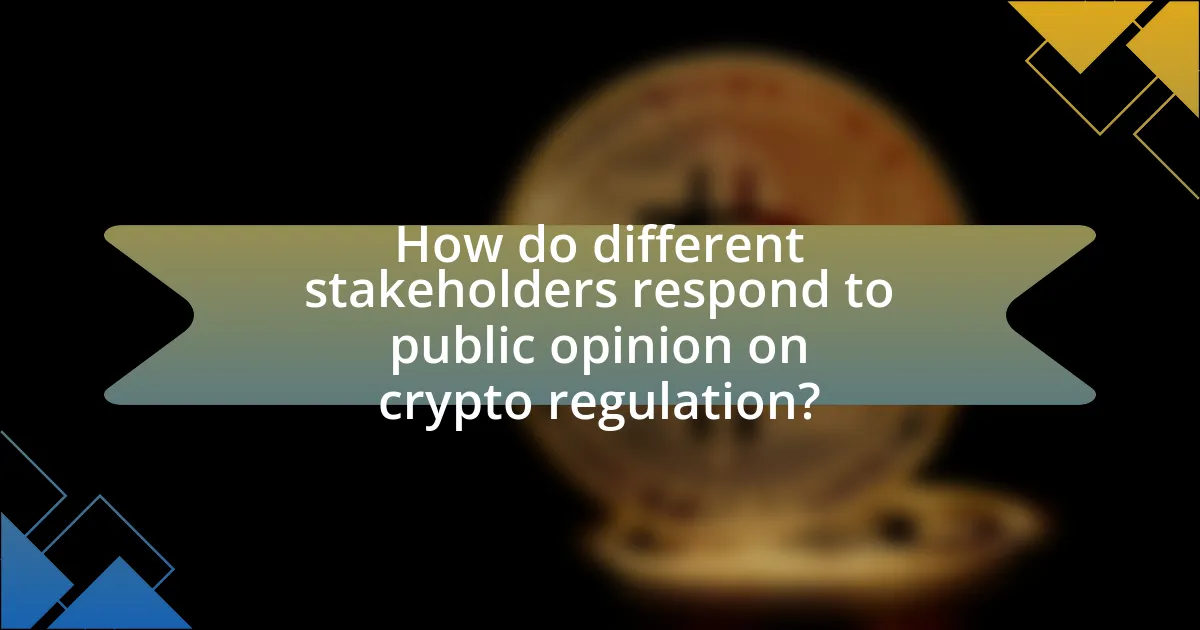
How do different stakeholders respond to public opinion on crypto regulation?
Different stakeholders respond to public opinion on crypto regulation by adjusting their strategies and positions based on the prevailing sentiments. For instance, government regulators often increase scrutiny and propose stricter regulations when public opinion leans towards concerns about fraud and security, as seen in the aftermath of high-profile scams that raised public awareness. Conversely, industry players, such as cryptocurrency exchanges and blockchain companies, may advocate for more favorable regulations when public sentiment is positive, emphasizing innovation and economic benefits, as evidenced by lobbying efforts during periods of increased public interest in cryptocurrencies. Additionally, consumer advocacy groups may push for regulations that protect users, reflecting public demand for safety and transparency in the crypto market. This dynamic interaction illustrates how public opinion significantly influences the regulatory landscape, prompting stakeholders to align their responses accordingly.
What strategies do regulators use to gauge public sentiment?
Regulators use surveys, social media analysis, and public consultations to gauge public sentiment. Surveys provide quantitative data on public opinions regarding regulations, while social media analysis allows regulators to monitor real-time discussions and sentiments expressed by the public. Public consultations, such as town hall meetings or open comment periods, enable regulators to gather qualitative feedback directly from stakeholders. These strategies are supported by studies indicating that public engagement can significantly influence regulatory outcomes, as seen in the 2020 U.S. Securities and Exchange Commission’s approach to cryptocurrency regulations, which incorporated public feedback to shape policy decisions.
How do industry leaders adapt to public opinion trends?
Industry leaders adapt to public opinion trends by actively monitoring social sentiment and engaging with stakeholders to align their strategies accordingly. For instance, they utilize data analytics tools to track public sentiment on social media platforms, enabling them to identify emerging trends and concerns. A notable example is how companies in the cryptocurrency sector have adjusted their messaging and compliance strategies in response to public backlash against perceived risks, such as fraud or environmental impact. This responsiveness is evidenced by the increased transparency and sustainability initiatives adopted by firms like Tesla and Coinbase, which have publicly committed to addressing environmental concerns related to cryptocurrency mining.
What role do advocacy groups play in shaping public perception?
Advocacy groups play a crucial role in shaping public perception by mobilizing support, disseminating information, and influencing policy discussions. These organizations often focus on specific issues, such as environmental protection or social justice, and utilize various strategies, including campaigns, lobbying, and public relations efforts, to raise awareness and sway public opinion. For instance, a study by the Pew Research Center found that advocacy groups significantly impact public attitudes toward climate change, demonstrating their effectiveness in altering perceptions through targeted messaging and community engagement.
How can public opinion be effectively measured in the context of crypto?
Public opinion in the context of crypto can be effectively measured through surveys, social media analysis, and sentiment analysis tools. Surveys can gather quantitative data on public attitudes towards cryptocurrencies, while social media analysis can track discussions and trends related to crypto, providing qualitative insights. Sentiment analysis tools can process large volumes of online content to gauge overall public sentiment, revealing how people feel about specific cryptocurrencies or regulatory issues. For instance, a 2021 study by the Cambridge Centre for Alternative Finance found that 76% of respondents were aware of cryptocurrencies, indicating a significant level of public engagement that can be quantitatively assessed through targeted surveys.
What methodologies are used to assess public sentiment on cryptocurrencies?
Surveys and sentiment analysis are the primary methodologies used to assess public sentiment on cryptocurrencies. Surveys gather quantitative data through structured questionnaires, allowing researchers to quantify opinions and trends among different demographics. For instance, a survey conducted by the Cambridge Centre for Alternative Finance in 2021 revealed that 76% of respondents were aware of cryptocurrencies, indicating a growing public interest.
Sentiment analysis, on the other hand, employs natural language processing techniques to analyze social media posts, news articles, and online forums to gauge public sentiment in real-time. A study published in the Journal of Financial Stability in 2020 demonstrated that sentiment analysis of Twitter data could predict cryptocurrency price movements, highlighting its effectiveness in capturing public sentiment.
Together, these methodologies provide a comprehensive understanding of how public opinion influences cryptocurrency regulation and market dynamics.
How reliable are surveys and polls in reflecting public opinion on crypto?
Surveys and polls are moderately reliable in reflecting public opinion on crypto, but their accuracy can vary significantly based on methodology and sample size. For instance, a survey conducted by the Pew Research Center in 2021 found that 86% of Americans had heard of cryptocurrency, indicating a high level of awareness, but the actual understanding and sentiment towards crypto can differ widely among respondents. Additionally, polls that utilize small or non-representative samples may lead to skewed results, as seen in various studies where demographic factors influenced responses. Therefore, while surveys and polls can provide insights into public sentiment, their reliability is contingent upon rigorous design and execution.
What best practices can be adopted to align crypto regulation with public opinion?
To align crypto regulation with public opinion, regulatory bodies should engage in transparent communication and public consultations. This approach allows regulators to gather insights and concerns from the community, ensuring that regulations reflect the values and needs of the public. For instance, a survey conducted by the Cambridge Centre for Alternative Finance in 2021 indicated that 70% of respondents favored regulations that protect consumers while promoting innovation. By incorporating public feedback into the regulatory process, authorities can create a more balanced framework that fosters trust and acceptance among stakeholders.










